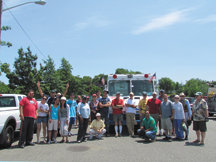Those living alongside Newark Bay have always suffered from waste washing up on the shore. If it falls off a boat or a dock, or flows down from a street or a yard, it eventually makes its way into Newark Bay.
And as often as people go to the shores to clear away the debris, within a few days, the tides fill up the western shores of Bayonne with junk again.
During the school year, local schools participate in the “Cleaner and Greener” program. They visit areas that are overrun with junk to do their part in cleaning up – in conjunction with the Passaic Valley Sewerage Commission, which has its own cleanup programs several times a year.
On July 10, The Hackensack Riverkeeper, an environmental group with offices in Bergen County, sponsored a river cleanup at DiDomenico-16th Street Park in Bayonne, providing tools, gloves, trash bags, and refreshments for volunteers. The clean-up involved working from the shore and from canoes.
“The water was so full of junk, we would have had to keep constant watch.” – Bill Sheehan
____________
Riverkeeper Bill Sheehan, a one time cab driver, rock and roll band drummer, and an environmental activist, has long been involved with the Hackensack Watershed, often coming to Newark Bay as part of his tour of duty, since clean rivers up north also benefit communities such as Jersey City and Bayonne.
Sheehan said that as late as the mid-1990s, Newark Bay was almost impassable to many recreational boaters because of the massive amount of junk that floated in the water.
“The water was so full of junk we would have had to keep constant watch,” he said during a recent visit to Bayonne.
But he said the most telling sign of the recovery of the ecosystem was the return of wildlife – varieties of fish making their way back – followed by an equal variety of birds and other animals who feed on the fish.
Sheehan doesn’t only come to Bayonne to help clean up the shores, but also to offer his expertise. He has worked with the Urban Angler Program, which has allowed Bayonne students to study their local environment to further understand the impacts humanity has on local waterways and what can be done to help restore and preserve the natural resources.
In his lessons, Sheehan talks not just about the water, but also about the historic and current industrial uses for regions on all sides of Newark Bay.
Yet the shoreline that had once been the host of polluting industries and their vacant aftermath is now being converted to new and more environmentallyfriendly uses.
Much of the improvement to Bayonne’s shoreline, Sheehan said, has to do with improvements made by the Bayonne Municipal Utilities Authority to the local drains that keep junk from flowing from the streets into the waterways.
Sheehan’s organization once sued Bayonne to bring the city into compliance with various other sewerage related issues. But since then, the Bayonne Municipal Utilities Authority and the Riverkeeper have become fast allies, working together on many projects including cleanup efforts such as this one.
While cleanup and education programs are the most visible role of the Riverkeeper, the primary mission of the group is to provide representation for the natural living resources of the Hackensack River. Sheehan said bringing people into contact with local waterways is the best way to force the state and federal government into expending the resources necessary for cleaning up old pollutants.
